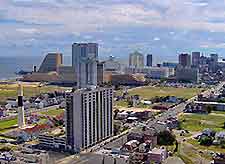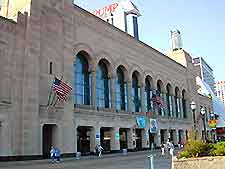Atlantic City History Facts and Timeline
(Atlantic City, New Jersey - NJ, USA)

With its prime real estate and setting in South Jersey, Atlantic City has always had a penchant for mass tourism.
Home of the Monopoly board game, the breezy town attracted holidaying folk from
New York with its giant hotels, boardwalk and later, mega casinos. There are also several noted historic attractions in Atlantic City, amid the glitz and glamour of the casinos.
The Arrival of the Boardwalk
Atlantic City was realized towards the end of the 18th century and was incorporated in the mid-1800s after a rail link from Absecon Island to
Philadelphia was installed. This event in history brought in many holidaying New Yorkers and Philadelphians, and the first commercial hotel, Belloe House, was opened.
Along with its world-famous Boardwalk, many other attractions from the history of Atlantic City date from the late 1800s. They include the Absecon and Cape May lighthouses, the massive Lucy the Elephant building and the Central Pier, with its fun games for kids. The Boardwalk itself came about in 1870, being erected along the beach to prevent sand getting into hotel lobbies and, more importantly, to allow visitors to stroll along the seafront. It became hugely popular and was expanded through the years, eventually stretching from Atlantic City to Longport (about 7 miles / 11 km) before the 1944 Great Atlantic Hurricane hit.
Today, the Boardwalk is some 4 miles / 6 km in length, spanning from the Absecon Inlet to the city environs and including many attractions. Piers remaining include the Steel Pier (1898), which sits near the Trump Taj Mahal, and the Garden Pier.

Early Atlantic City Hotels
Atlantic City has always been big with hotels, and they really sprung up after the construction of the Boardwalk, including the likes of the Surf House and the United States Hotel. The city went through another boom period in the early 1900s, when many older places along the Boardwalk were either demolished or turned into hotels. The Traymore and the Marlborough-Blenheim were particularly prominent lodgings, while others included the Chelsea, the Ambassador and the Mayflower.
Tourism remained big into the 1920s and the Miss America pageant was held here, while liquor was drunk like water in backroom clubs during Prohibition. However, as in other coastal cities, the post-WWII period in Atlantic City history saw a partial demise into corruption and seediness. In addition, people started going to Florida for holidays, with the introduction of flights.
Atlantic City Revival
The big turnaround came with the legalization of gambling in 1976, with many casinos being built along the Boardwalk and within the Marina District. Resorts International was the first legal casino, while today there are a dozen or so and several new ones in the pipeline. However, with the economic uncertainty of the late-2000s, many planned mega casinos never made it off the drawing board, including the MGM Grand Atlantic City.
The powers that be have looked to other methods of attracting tourists. Parks and shopping areas have been built near the beach, while the ambitious Tourism District is hoped to set the city apart from emerging competition and make history in Atlantic City, featuring new and redeveloped districts along with new roadways.
 With its prime real estate and setting in South Jersey, Atlantic City has always had a penchant for mass tourism.
With its prime real estate and setting in South Jersey, Atlantic City has always had a penchant for mass tourism.